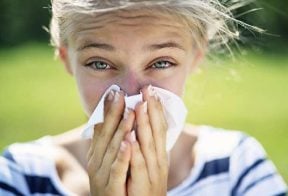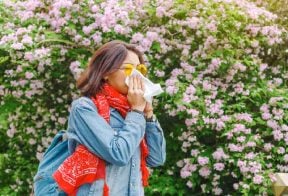
While you might automatically assume that you’re coming down with a cold, it could also be connected to winter allergies.
Typically, seasonal allergies happen in the fall; however, the winter is also a time when allergies thrive indoors.
Winter allergy symptoms generally include a runny nose, itchy/watery eyes, and sneezing. To find relief, we are sharing more about how to deal with a cold, flu, or allergies and how Kleenex® Brand Tissues.
Can You Get Allergies in the Winter?
Common allergens such as pollen, grass, and weeds are not the only allergens you should be on the lookout for. In fact, some of the most common allergens are hiding right under your nose, in your home.
And while you’re staying indoors trying to escape the cold, harsh winter weather, you expose yourself to these allergens, breathing them in.
What are Common Winter Allergies?
 To manage your allergies, it’s important to know what to look for. Scan your home to figure out if these winter allergy causes are hiding in plain sight.
To manage your allergies, it’s important to know what to look for. Scan your home to figure out if these winter allergy causes are hiding in plain sight.
Dust
Dust is one of the main contributors to allergies. It consists of tiny particles of dead skin cells, pet dander, pollen, dirt, and more. Interestingly, you might even find that your allergies act up after you’ve swept or vacuumed. This is because, during the cleaning process, you’re stirring up the dust and inhaling more of it.Pet Dander
Unfortunately, your beloved pets might be causing your allergic reaction. This allergy is not actually caused by their fur but rather by a protein in their skin, fur, urine, and saliva that may cause a reaction.Mold
Thriving in dark, moist areas, mold is a fungus that loves to live in your bathroom and under sinks. These fungal spores can become airborne and latch onto your clothes and other fabric around the home, making it even easier for you to inhale.Dust Mites
As tiny relatives to the spider, dust mites feed on all the particles that make up dust. Because they’re too small to see you might not even be aware that they’re living in your bed, furniture, or curtains. Like pet dander, the protein in dust mite poop and the skin cells of their dead bodies are what triggers an allergic reaction.Winter Allergy Symptoms Vs Other Winter Diseases
| Symptom | Winter allergies | Cold | Flu |
|---|---|---|---|
| Coughing | Yes | Yes | Yes |
| Dark circles under your eyes | Yes | Sometimes | Sometimes |
| Itchy eyes andnose | Yes | Rarely | Rarely |
| Runny nise | Yes | Yes | Yes |
| Sneezing | Yes | Yes | Sometimes |
| Fever | No | Sometimes | Yes |
| Muscle aches | No | Rarely | Yes |
| Tiredness and weakness | Sometimes | Sometimes | Yes |
| Sore throat | Sometimes | Yes | Sometimes |
| Headache | Sometimes | Sometimes | Yes |
The cold and flu share a few overlapping symptoms but are ultimately caused by completely different contagious viruses. The flu is caused by the Influenza virus; while colds can be caused by multiple different viruses, with the most common one being the Rhinovirus. Your cold symptoms will also usually be milder than flu symptoms.
By understanding the differences between your winter allergy symptoms and these illnesses you’ll be able to create a more effective treatment plan.
Alleviating Winter Allergies
When you encounter these allergens, they trigger a defensive response in your immune system. This is when your body creates mucus that can cause a cough and sneezing to try and get the allergens out of your body.
Now that you know how to identify whether you’re suffering from a cold, flu, or winter allergies it’s time to figure out how to treat it with the tips below.
Bathe Pets Consistently
When it comes to managing your pet-triggered allergies there are a few things you can do to minimize your symptoms. Washing your pets regularly (at least once a week) and brushing them is a great way to reduce the amount of dander (dead skin cells, hair) they shed.Although cuddling them may make you feel warm and cozy, washing your hands after petting your dogs or cats is essential. You can also create “allergy-free” zones in your home where your pets are not allowed to go, like your bed or the couch, helping to relieve your symptoms.
Vacuum Your Home Regularly
Keeping a regular cleaning schedule is a surefire way to minimize your exposure to allergens like dust, dust mites, pet dander, and more. When you’re vacuuming, be sure to get into every nook and cranny, getting behind and underneath your furniture where these allergens are likely to build up.Clean Furnace Filters
Your furnace filters are a critical part of allergy control but over time they can become clogged with pet hair, dander, and other allergens. By changing your furnace filter regularly, you can help keep your air clean, alleviating your winter allergy symptoms.Protect Bedding from Dust Mites
These tiny little bugs love to make their homes in places where your dead skin cells and the dead skin cells of your pets are likely to land. Cleaning regularly is your best bet.On your cleaning days make sure to tackle your bedding, curtains and carpeting. Wash everything in hot water to kill any existing dust mites. Also, by being proactive and using zippered mattress and pillow protectors you can keep your place of rest bug-free.
Combat Winter Allergies with Kleenex® Facial Tissues
Don't let winter allergies hold you back this season! Stay prepared this season with Kleenex® Facial Tissues.
- https://www.webmd.com/allergies/winter-allergies
- https://www.webmd.com/allergies/features/winter-mold-allergies-risk
- https://www.zyrtec.com/allergy-guide/outdoors/understanding-winter-allergies
- https://www.nationaljewish.org/conditions/allergy/overview/lifestyle/winter-tips#:~:text=Some%20common%20symptoms%20of%20indoor,necessary%20for%20dust%20mite%20survival







